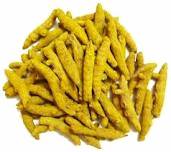Spices Products
Spices >> Turmeric
Turmeric

Turmeric is the boiled, dried, cleaned and polished rhizomes of Curcuma longa. The plant is a herbaceous perennial, 60-90 cm high, with a short stem and tufted leaf. There are 7 to 12 leaves, the leaf sheaths forms the pseudo stem. The lamina is green above and pale green below and has a length of 30-40 cm and width 8-12 cm. Inflorescence is a central spike of 10-15 cm length. 1-4 flowers are born in axil of the bract opening one at a time. About 30 flowers are produced in a spike. Seeds are produced in capsules and there will be one to numerous sunken capsules in an inflorescence.
Origin
It is a native of India.
Uses
Turmeric is used to flavour and to colour foodstuffs. It is a principal ingredient in curry powder. Turmeric oleoresin is used in brine pickles and to some extent in mayonnaise and relish formulations, non-alcoholic beverages, gelatins, butter and cheese etc. The colour curcumin extracted from turmeric is used as a colourant.
Turmeric is also used as a dye in textile industry. It is used in the preparation of medicinal oils, ointments and poultice. It is stomachic, carminative, tonic, blood purifier and an antiseptic. It is used in cosmetics. The aqueous extracts has biopesticidal properties.
Botanical name - Curcuma longa L.
Family name - Zingiberaceae
Commercial part - Rhizome or underground stem
Name in international languages
Spanish : Curcuma
French : Curcuma
German : Kurkuma Gelbwurzel
Swedish : Gurkmeja
Arabic : Kurkum
Dutch : Geelwortel
Italian : Curcuma
Portuguese : Acafrao-da-India
Russian : Zholty Imbir
Japanese : Ukon
Chinese : Yu.Chin
